 |
|
 |
|
|
If your browser labels this site "Not Secure," click here.
|
|
2018
August
29
|
Is Google biased? Some thoughts...
President Trump's denunciation of Google for being biased against him raises the question
of whether Google really is biased, and if so, whether anything should be done about it.
Here are some thoughts.
If you are not technically familiar with the Internet, make sure you understand this:
Your connections to web sites do not go through Google. Google cannot "block" you from accessing any web site.
Google is just an index that helps you find web sites. Even if Google doesn't link to a web site at all, you can go to it by typing its address or by following a link on another web page.
If your browser is Microsoft Edge
or Internet Explorer, you are probably never using Google anyway;
Microsoft normally uses the Bing search engine, which is Google's arch-competitor.
|
Now for my thoughts...
(0) There are reliable reports that Google has offered to build a politically censored search engine for China.
Thus, some concern about censorship by Google is warranted; it does not seem to be against their principles.
(1) Google is not the only search engine. You can use others, such as
Bing (Microsoft),
DuckDuckGo (extra privacy),
and
Dogpile (extra coverage of obscure sites).
Try them!
I am actually using the first two most of the time, rather than Google, because they
index my own web site better than Google does.
I do not think everyone's access to information should be channeled through
a single company! A free Internet needs multiple competing search engines.
Even if Google has no deliberate bias, it will not always find what you want to find.
(2) If the media are biased against Trump, and Google is accurately retrieving the media,
then Google will show the same bias. This is not Google's fault. It's what we expect
from accurate indexing of what's out there.
It is well known that the news media do have
something of a left-of-center bias,
and part of the reason is simple: the left wing makes more news than the right wing.
People who want to overthrow tradition introduce more new ideas than people who want
to preserve it.
At the same time, bias does not mean the media are reporting falsehoods,
only that they have preferences and slants. Actual false "fake news" circulates in memes on Facebook,
not on Fox or CNN or NBC.
I think a well-informed person should read "biased" media
(with appropriate critical thinking, of course) in order to find out what
other people think is important. If you only read media that support your opinions, there
is too much you will never hear about. I am not looking for media that are "biased" my way,
or will keep quiet when certain things go wrong, which
is what a lot of people are now demanding.
(3) A good search engine will try to track ideas to their source and will tend to link to
sites that originate new ideas rather than sites that oppose them. This probably amplifies the bias I just mentioned,
and I don't think it's the search engine's fault.
We have to remember that politics is not what search engines were designed for.
They were designed for simple information retrieval, not sorting out bitter controversies.
(4) BIG POINT: Google tracks your interests and keeps track of what kind of links you have clicked through.
It tries to show you more material of the same kind.
Two different people using Google, with different search histories, will not get the same results.
If you've been looking for anti-Trump sites, Google will lead you to more anti-Trump sites!
(5) Trump's use of the word "illegal" alarms me. Biased news coverage is not illegal and never can be,
under our First Amendment. Censoring news media or search engines that are "biased" is not the American way.
(6) Loyal Trump followers should not be told not to use Google. Right-wing chit-chat is already
telling people not to use Snopes or Wikipedia. Has Google just been put on the list? What about other
search engines? What else are loyalists being told not to read and not to know?
I thank many Facebook friends for a conversation that is distilled here.
Melody and rhythm: We've managed to keep Melody out of hospitals for more than a year,
but Sunday night, she had to go in for one night with a heart rhythm disorder. It's sorted out now
and she came out feeling better. Thanks to all who expressed concern while this was going on.
Permanent link to this entry


|
2018
August
25
|
We need multiple interlinked social media
Facebook is running the country. It is a huge number of people's main source of
information about current events. The boundary between social media and news media
has become blurred, and we have problems with hoaxes, falsifications, and propaganda
spreading like wildfire.
It is fundamentally unclear whether Facebook is supposed to be a common carrier,
delivering all messages for everyone, or an edited, curated news service like CNN or Fox,
delivering what the editors consider accurate and important.
And Facebook is a natural monopoly. It works best if everyone is on it.
Checking two or three different social media, and not knowing which one to find our
friends on, would be burdensome to all of us.
The problem is, a natural monopoly does not mix well with any attempt to control fake
news and spam. The reason is that, due to bias, malice, error, incompetence, or mere
difference of opinion, the editors might suppress a legitimate and important news story.
Facebook has been cracking down on fake news, and today President Trump complained
bitterly about how it was "silencing millions."
To get around this, we need multiple, independently run social media. All can fight spam
and fake news, but each in its own way. If customers find one of them unreliable, they
can switch to another. If there is ground for real difference of opinion about an item, they
will not all handle it the same way.
Also, different customers will have different preferences about what should be filtered out
and how the filtering should be done — do you want dubious
messages removed, or just accompanied
by warnings?
But the media need to be interlinked. Each needs to be able to communicate with people who
are on the others.
This isn't trivial, but it can be done.
E-mail has been interlinked as long as most people can remember, but there was a time
when most universities couldn't send e-mail off campus, AOL could only send to AOL,
and CompuServe could only send to CompuServe.
There was even a time when telephone companies weren't interlinked, and some cities
had more than one telephone company, requiring businesses to subscribe to both of them
in order to call all their customers.
Creating multiple social media, and interlinking them, can be done.
The hardest part is arranging a way to split up the advertising revenue.
If we had a less turbulent government, I would say this might be a job
for the FCC, regulating and breaking up a natural monopoly.
It certainly raises the possibility that maybe we should pay for social media,
rather than having them funded by advertising.
Right now, we are their salable product.
Permanent link to this entry


|
2018
August
24
|
Another walk across the moon
I took another pair of pictures of the moon on the evening of the 23rd.
The air was not as steady, so the pictures were not quite as sharp,
so they are presented at slightly lower magnification.
5-inch telescope.
First, the northern terminator region, including the bright crater Aristarchus,
the Bay of Rainbows (Sinus Iridum), and the great crater Copernicus at the bottom.
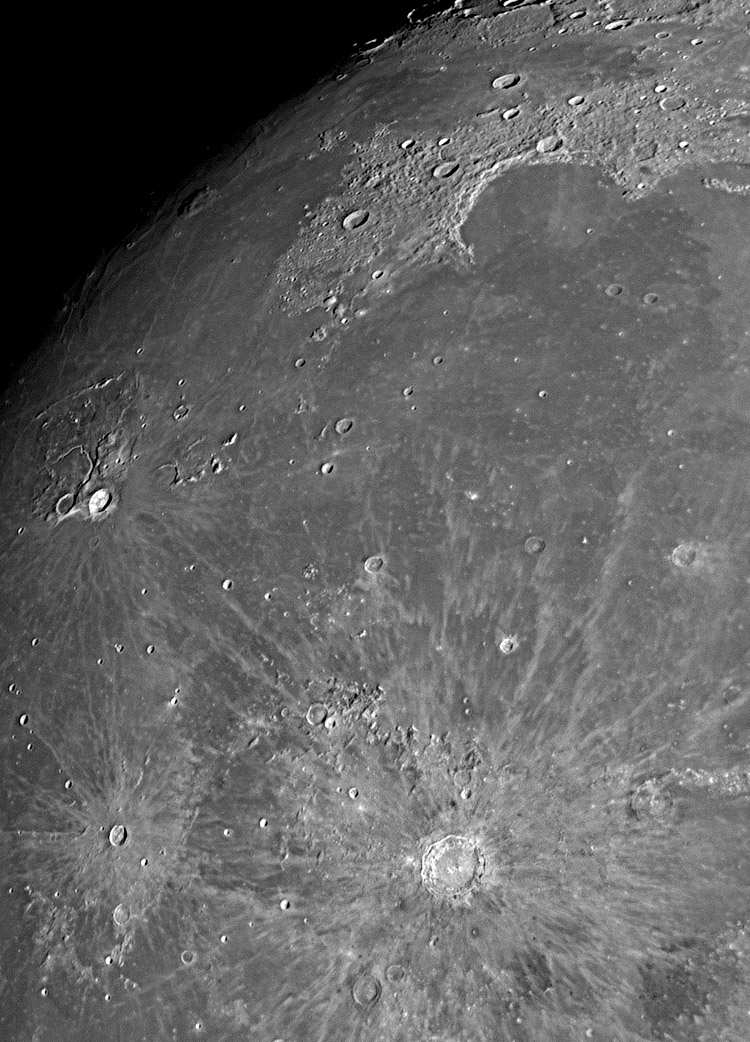
Then the heavily cratered southern region; you can tell that Tycho (the crater with
the rays) is the most recent impact and that its ejecta have left marks over a wide area.
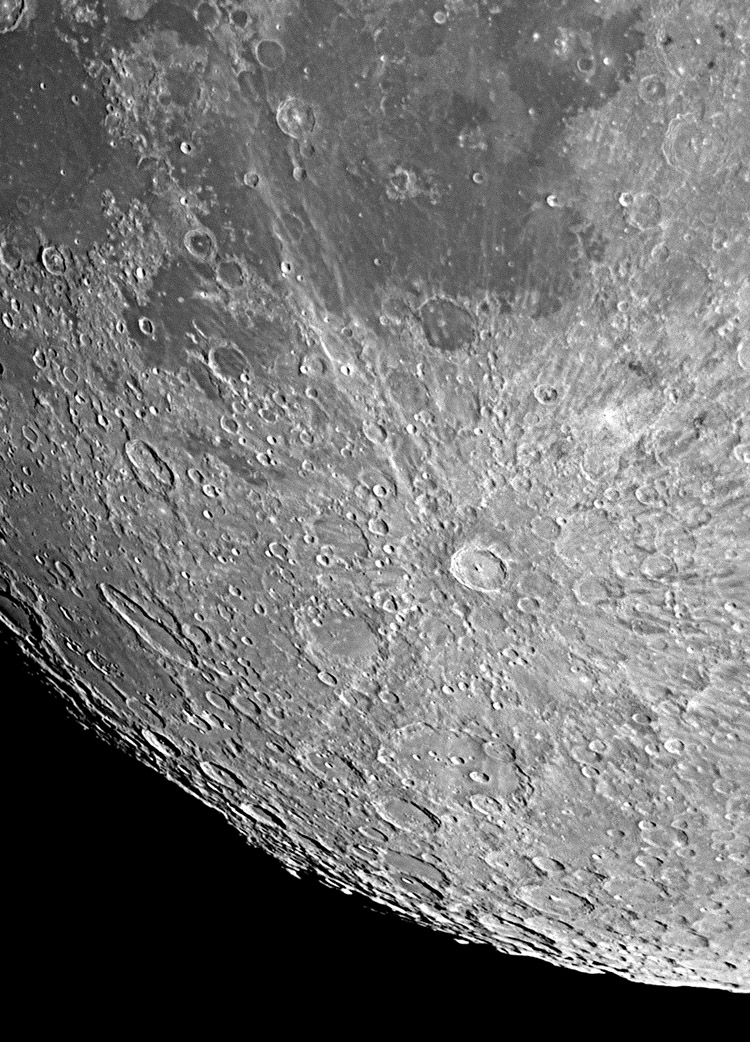
Permanent link to this entry


|
2018
August
23
|
A walk across the moon
On the evening of the 19th, I took some wide-field, low-magnification pictures of the moon
using my vintage 1980 Celestron 5 and the new ASI120MM-S camera. These are infrared images.
First, the northern terminator region of the gibbous moon, dominated by the Apennine Mountains
and showing many other interesting features:
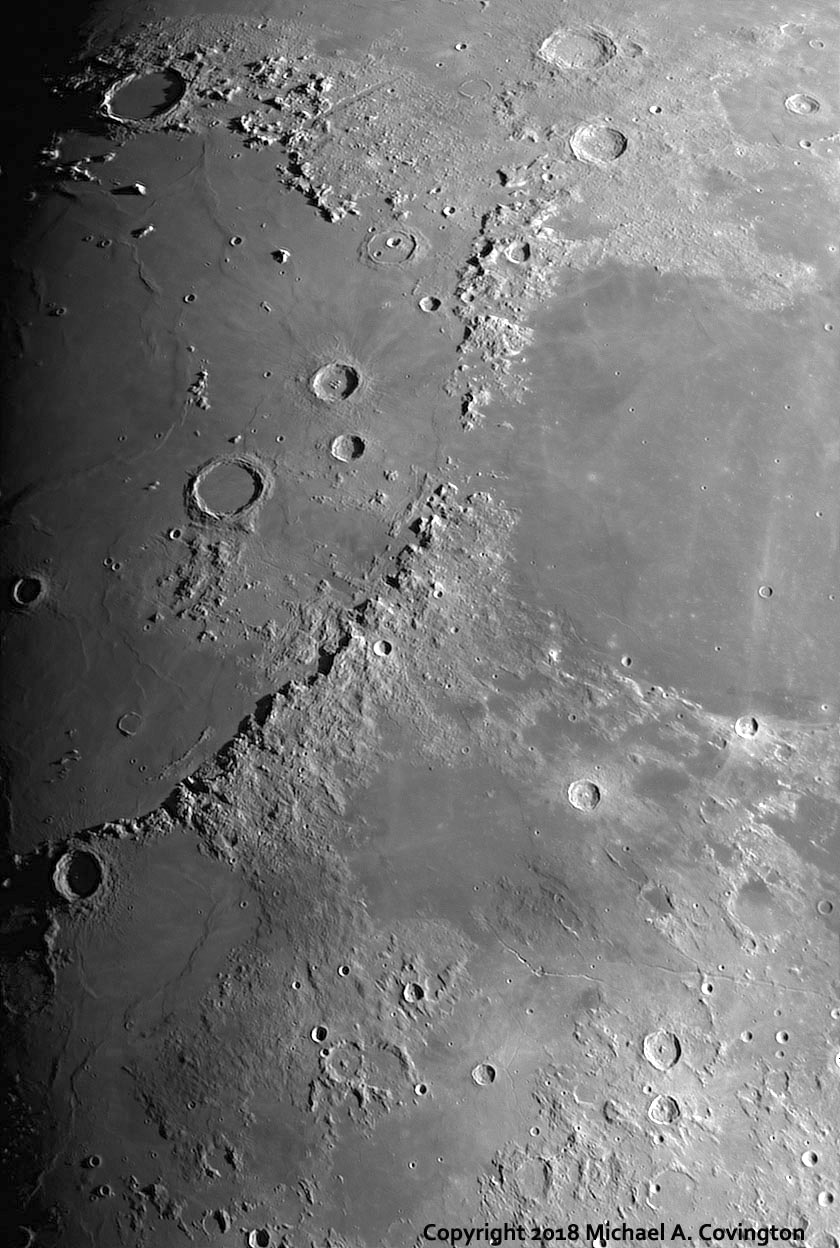
Next, the region just to the south; the two pictures do not quite connect.
Note the complex crater Stofler, actually five craters stacked by consecutive impacts,
near the center.
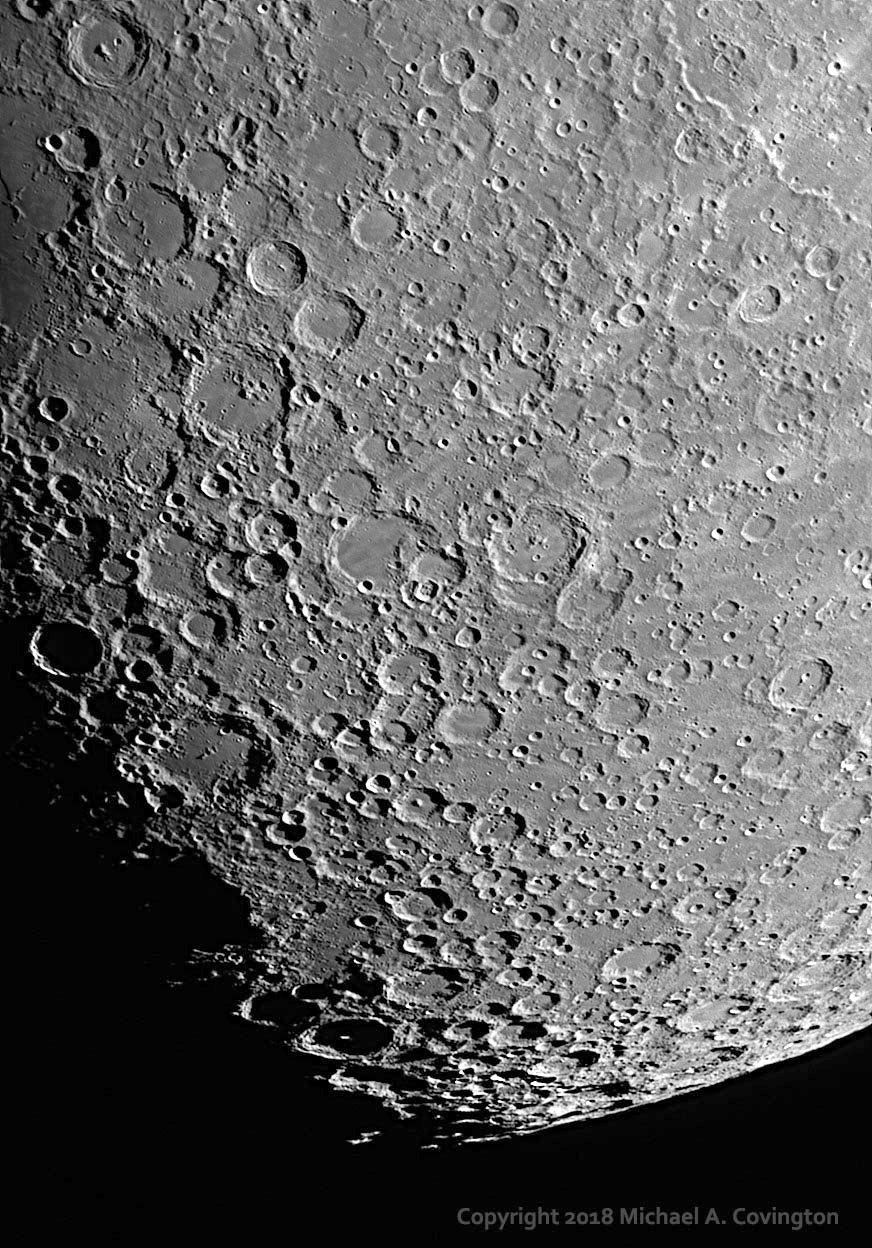
A huge range of lunar features are shown here. You'll need a
map of the moon
to begin to recognize them. Or just enjoy the view.
Permanent link to this entry
Planets on the evening of August 14
These images of Jupiter and Saturn are not outstanding, but they do document
conditions on those planets at the time. Jupiter was photographed in twilight;
it has moved around the Solar System far enough that we no longer see it high
in the sky late at night. 8-inch telescope.
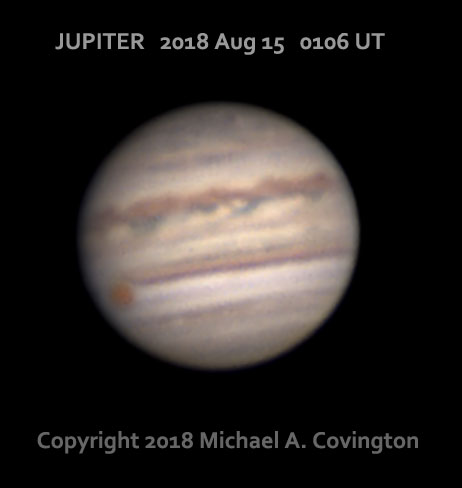
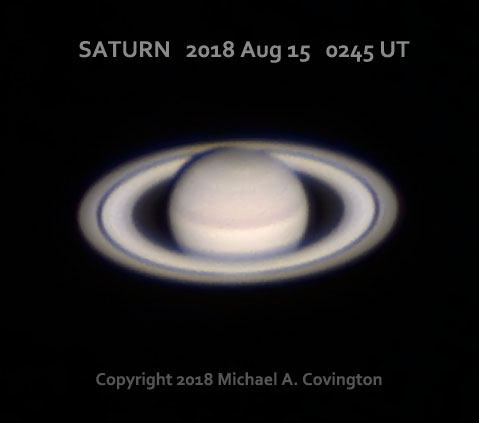
Permanent link to this entry
My observing assistant
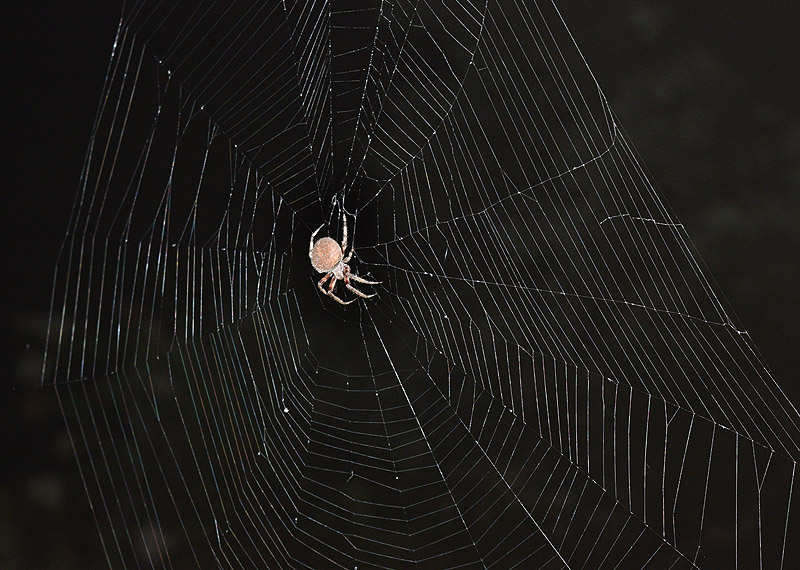
Since early summer, this orb-weaving spider has been helping me do astronomy by building
large webs and trapping mosquitoes near where I set up the telescope.
In recent weeks she has been popular with the male spiders, having attracted (and apparently
eaten) two or three mates. (Eating them after mating is normal; they usually don't survive
mating anyhow. I'm glad humans don't work that way.)
During the day, she has been sleeping in the red light fixture by whose light I set up the telescope;
realizing this, I have refrained from turning on that light while she is in it.
Every evening, her habit has been to come out and build a web.
I don't know if this is the same spider
that helped me in a similar way last year.
What I do know is that she has disappeared. About four nights ago she changed the habitual
position of her web slightly, making it bigger, and about two nights ago she stopped building
webs and has not been seen. I don't know if something has happened to her or if she simply
succumbed to wanderlust and relocated elsewhere.
Permanent link to this entry


|
2018
August
22
|
How news media bias works
Facebook has reported that it found and removed Russian and Iranian propaganda
accounts, which implies there are more that haven't been found yet.
Here's something I posted on Facebook as a response to people who are easily confused:
Don't let people keep you ignorant. Don't obey people who tell you not to use reliable sources of information.
When a source is "biased," that does not mean it is making up facts out of thin air. It just means it has a preference for some facts, and for interpreting facts a particular way.
For example, when CNN says yesterday was a very bad day for Trump, that's their interpretation. But when CNN says Manafort was convicted on 8 charges, that is a hard fact that you can verify elsewhere. They're not making it up.
We've all been told (by some total stranger) not to believe Snopes and Wikipedia because they are "biased." That is foolish, especially because we don't know who the total stranger is who supposedly warned us.
Snopes,
Wikipedia, and even the
Encyclopaedia Britannica can contain mistakes and have biases, but they are full of solid hard facts, and they give you links to help you verify them elsewhere. Though not perfect, they are reliable.
Pay attention to the hard facts, the things you can confirm elsewhere, the things that would cause an outcry if they were reported incorrectly. You'll learn that outright false reporting is quite rare.
Permanent link to this entry
Fishing for the gullible?
I also want to point out what I suspect may be a propaganda technique,
though I have no proof.
It is certainly something to watch out for.
Simultaneously with this flurry of foreign propaganda, Facebook has been abuzz with a new version of the
"two moons on August 27" story,
with a picture.
I wonder if propagandists fish for gullible people by spreading an unbelievable
story with no credible source and seeing who believes it and spreads it.
After all, Facebook tells them who "likes" it and shares it. It's not secret.
Those are the people who will also swallow political misinformation.
After all, if you can believe in two moons, it's not hard at all to believe
some false political conspiracy theory.
I don't know if they're really doing that.
But I've seen evidence that scammers "fish" for potential victims using a related
technique, and if I were a propagandist, I'd be doing it, now that I've thought of it.
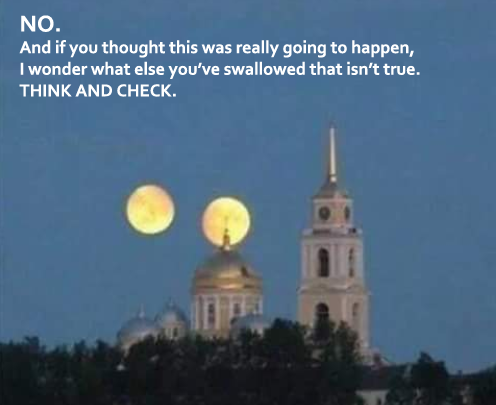
Permanent link to this entry


|
2018
August
20
|
Mars (with craters?)
The discovery of craters on Mars by the Mariner 4 space probe in 1965 came as a shock
to astronomers. Earth-based telescopic observers had been split between the opinion that
there were thin lines ("canals") on mars, and the rival, correct, position that there were
rows of irregular spots, which looked like lines when not seen clearly.
Today we get far better digital images of Mars than visual observing ever made possible.
Inspired by some
remarkable work by
Brett Turner, who has a 14-inch telescope and sees Mars high in the sky over Australia,
I decided to see if I could photograph craters, or at least the spots that correspond to them.
The verdict? Maybe so, although of course you can't tell that the spots are craters.
Here's what I got on the evening of the 14th with my 8-inch telescope. The black-and-white image
is in near infrared light (just outside the visible spectrum).
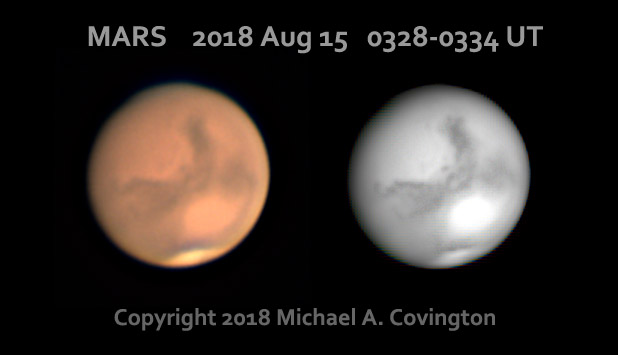
Here's a software-generated map to identify the main features:
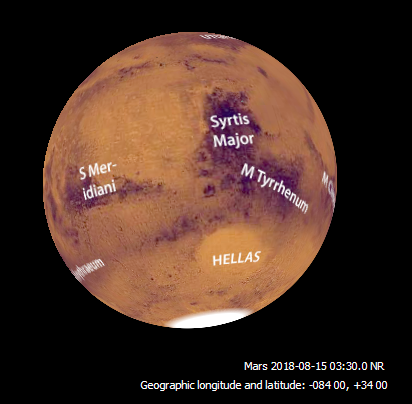
Now the trouble with Mars is that the brightness features (light and dark) do not correspond
very well with the surface features (mountains, craters, etc.), and most planetary scientists
are only interested in the latter.
By using this map of the surface features,
and this
crucial map that shows surface and brightness features
together (though without labeling anything),
I was able to identify two spots, west of Syrtis Major, that do correspond
to craters. (The third spot, between them, does not correspond to a crater,
at least not one deep enough to show up on the surface-feature map.)

Should I claim to have photographed craters on Mars? No, because there is no
way to tell from the picture that these spots are craters.
But we now know that they correspond at least roughly to craters; they must be places
where a different type of windblown sand has settled than elsewhere, due to the crater
depressions.
What is certain is that, like many other amateurs, I am photographing
brightness features that are not on the old maps and do not have names.
Permanent link to this entry


|
2018
August
19
|
Is Pluto (or anything else) a planet?
A truly scientific approach
People still argue about whether Pluto is a planet and whether the list of nine planets they
memorized in school is "wrong."
The bottom line is that there is no definition of "planet" that will give us exactly the original
list of nine. If Pluto is a planet, then so are Ceres and several other objects.
I wrote about this back in 2015.
But we can be more scientific. The first step is to make up our minds whether we are classifying
what objects are or where they are.
In Copernicus' and Galileo's time, "where" was the only criterion;
nobody knew what the planets were like physically.
So planets orbit the sun, satellites orbit planets, and stars are far away and don't seem to move.
That's how many people still understand it.
The problem is, we now know that the Moon and Mercury are very similar objects.
(Quick, which one is this a picture of? Click and look.)
But one orbits the sun and the other orbits the earth.
Classifying them by what they orbit is not helpful.
There are many similar examples.
The Earth and Mars resemble the largest satellites of Jupiter and Saturn more
than they resemble Jupiter and Saturn themselves.
It is not even helpful to distinguish planets that have their orbits all to themselves
from planets that orbit in swarms.
That was supposed to be the distinction between "dwarf planets" and "asteroids," a last-ditch
effort to keep Pluto out of the asteroid class.
It won't do.
If a planet turns out to have a companion in its orbit, surely that doesn't make it any less
of a planet.
So let's classify objects by what they are. And here a new discovery makes things really interesting.
Using machine-learning techniques, Jingjing Chen and David Kipping, of Columbia University,
modeled the relation between mass and diameter of hundreds of celestial objects
of all kinds. They found that it broke up into natural classes!
You can read their paper here.
The size of different kinds of objects depends on different physical processes,
and that's the key to classifying them in an illuminating way.
Chen and Kipping found these classes of objects, each with a different formula relating
mass to size:
(1) Terran (earthlike, hard-crusted) objects, up to about twice the mass of the Earth.
These include Mercury, Venus, Earth, Mars, the Moon, the asteroids (in both belts), and the
satellites of planets.
(2) Neptune-like objects, with a large, heavy, atmosphere, or to put it differently, no sharp
distinction between crust, ocean, and atmosphere. With increasing mass, these grow in size faster
than hard-crusted objects do. These range up to about 40% of the mass of Jupiter.
(3) Jovian (Jupiter-like) objects, which resemble Neptune-like objects except that their
gravity causes strong compression of the heavy atmosphere. The formula relating mass to size is
unusual — heavier objects in this class are actually smaller, due to stronger gravity.
(4) Stars, big enough to support hydrogen fusion. The more massive, the bigger they are.
By this criterion, Earth, Titan, and the Moon are all Terran objects; Saturn is just barely
a Jovian object; and, as astrophysicists have noted for decades, the only real difference between
a big Jupiter and a small star is that the star is big enough (and hence dense enough) to fuse
hydrogen.
There you have it. I would add one more distinction: it's handy to distinguish Terran objects
that are big enough to hold themselves in a round shape (such as Earth, Moon, and Ceres) from those
that are irregular and loose (like small asteroids). But this may not be a physically important
distinction. And how round does an object have to be? When the true shape of Phobos and Deimos was
discovered, Carl Sagan said they look like "diseased potatoes." And they do.
Permanent link to this entry


|
2018
August
16
|
Freedom of the press

Most of the newspapers in the United States are publishing editorials today in defense
of freedom of the press. So am I.
It is one thing for a head of state to point out specific inaccuracies or biases in news reporting.
Those occur and should be pointed out.
But it is quite different when, without specifics, the head of state habitually
hurls the words "fake news"
at any reporting that he doesn't like,
starts telling the American people not to believe news sources except for a few that
he approves of,
and labels the press (naming specific networks and newspapers) the enemy of the people.
It is even more distressing when people swallow it.
A nonnegligible number of Americans have now gotten into such a state of mind that
if CNN reports a fire in California or an election in Germany,
they will assume it is probably pure fiction, because "CNN is fake news."
I stand with the free press, accountable to factual accuracy and to reality itself,
rather than the fantasies of those who demand that facts go away when they stand in
the way of personal loyalty to a glamorous leader.
And I stand with the Constitution of the United States and against anyone who would degrade
our constitutionally protected free press.
Update: During the day, the United States Senate unanimously passed a resolution
saying, in part:
(1) the Senate ... condemns the attacks on the institution of
the free press and views efforts to systematically
undermine the credibility of the
press as an attack on the democratic institutions of the United States; and
(2) it is the sense of the Senate that it is the
sworn responsibility of all who serve the United
States by taking the oath to support and defend the
Constitution of the United States, to uphold, cherish,
and protect the entire Constitution, including the
freedom of the press.
Rarely does the Senate come so close to censuring the behavior of a sitting
President by unanimous voice vote (even if the last sentence is remarkably
awkward; I've added a comma).
I stand with the unanimous Senate as well as with the Constitution.
Permanent link to this entry


|
2018
August
13
|
Mars and Saturn again
Two clear nights in a row! At least, two nights with holes in the clouds in somewhat
suitable places. Last night I had considerably steadier air and got distinctly better
pictures. Here they are, along with a computer-generated Mars map. Same equipment and
techniques as yesterday (scroll down).
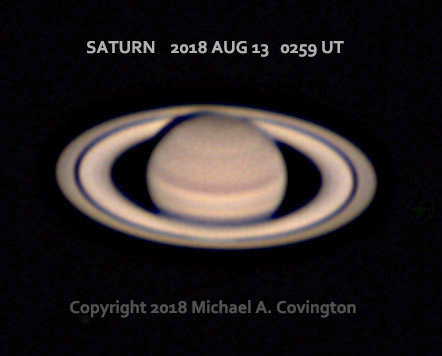
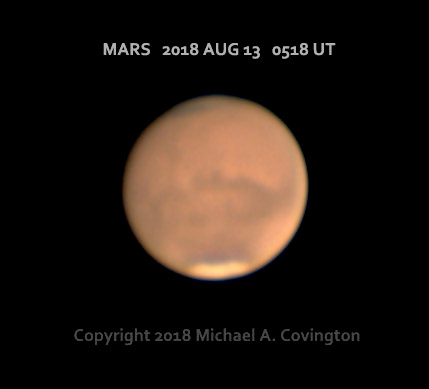
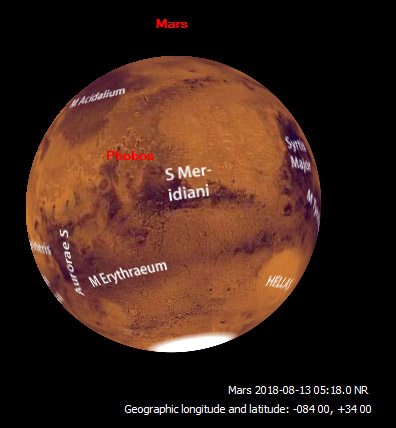
Permanent link to this entry


|
2018
August
12
|
Saturn and Mars
"The rain it raineth every day," and my astrophotography lately has been limited to
two mediocre pictures taken last night. I present these views of Mars and Saturn because,
although unimpressive, they do document the current conditions on those planets, and in
particular the diminution of the Martian dust storm. Here also is a map of Mars
generated with WinJUPOS to tell you what you're looking at.
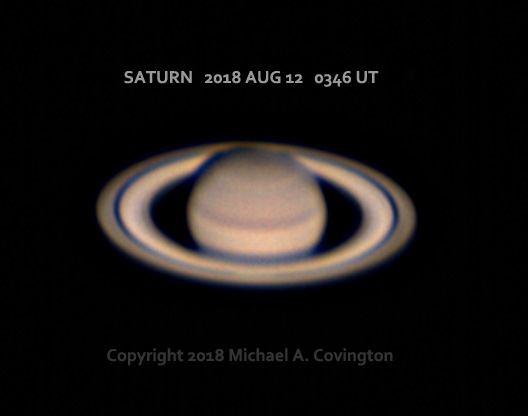
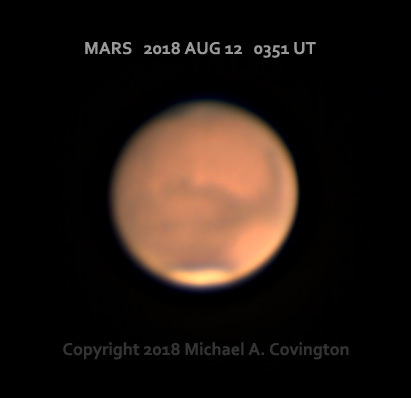

Taken with 8-inch Celestron EdgeHD, 2× focal extender, and ASI120MC-S camera.
Each is a stack of thousands of video frames.
Permanent link to this entry


|
2018
August
7
|
Sunset on Mare Crisium
Mare Crisium is the dark "eye" that you see in the evening crescent moon.
At that time, if you were standing in Mare Crisium, the sun would be high
in your sky. Sunset on Mare Crisium doesn't occur until after Full Moon as
seen from earth.
Here are two pictures of sunset on Mare Crisium, on July 27 and 28
respectively (so you can see sunset progressing). Both are infrared images
taken with an 8-inch telescope and ASI120MC-S or ASI120MM-S camera
respectively; thousands of video frames were stacked and wavelet-sharpened.
The brightness levels are different due to different processing decisions,
which are largely a matter of taste.
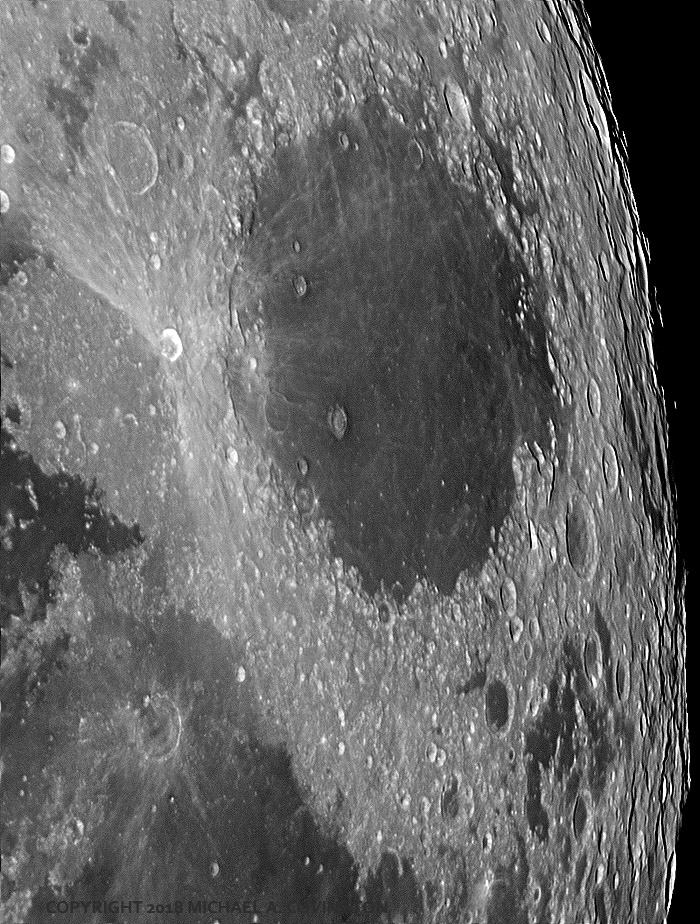
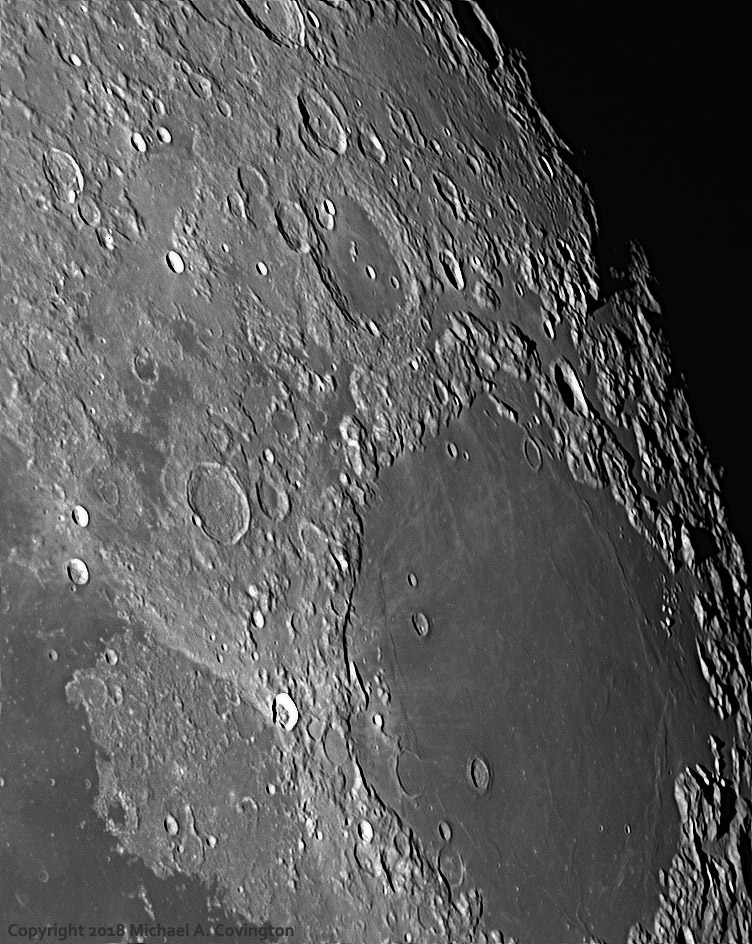
Permanent link to this entry
A comet-shaped crater to honor a comet hunter
Also from July 28, here is a more southerly region of the moon.
The most prominent crater is Langrenus.
At the upper left of center is a pair of craters, one of which has a tail
like a comet because material was ejected from it.
They are named Messier (right) and Messier A (left),
in honor of Charles Messier, the comet hunter
who is nowadays more famous for discovering many star clusters and
nebulae. He is the "M" in designations such as M31.
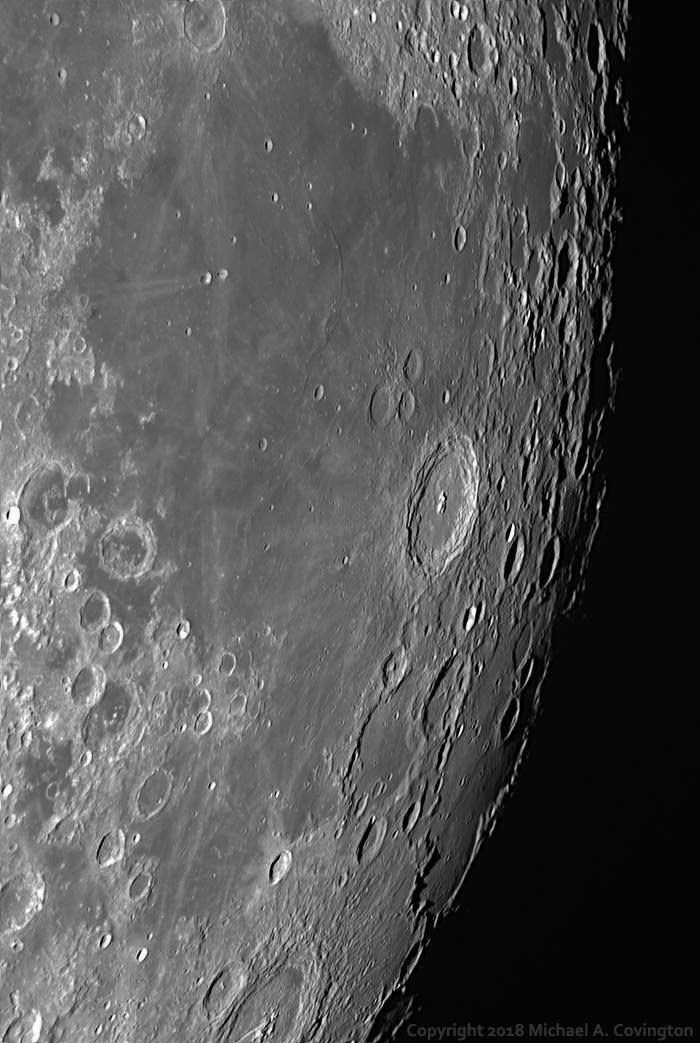
Permanent link to this entry
Petavius
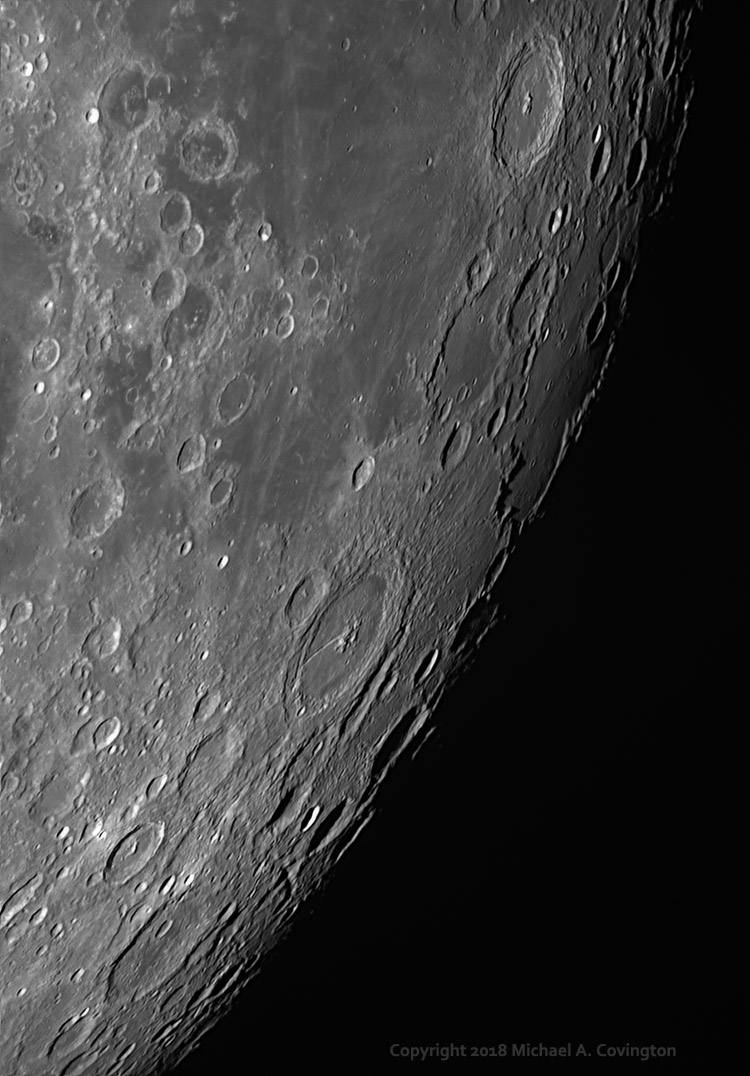
The most prominent crater here is Petavius, below center.
Higher up, you see Langrenus, as in the previous picture.
Both of those craters are large, with central peaks.
Petavius also has a rille, a long, relatively straight canyon caused by later
fracturing.
It is now generally agreed that lunar craters are not volcanoes.
They were formed by impact, back in a time when very large meteors were much more
common than today, and are round because an impact produces a circular shock wave
regardless of whether the impact is straight-on. (Messier, in the previous picture,
is a rare exception; the impact must have been at such a low angle as to create an
oblong crater and leave a ray of ejected material on only one side.)
The names Langrenus and Petavius are not familiar to most astronomers.
Langrenus published a map of the moon in 1645 and named a crater after himself,
and it stuck.
Petavius (Pétau) was a 17th-century theologian and historian.
Some sources also describe him as an astronomer.
Permanent link to this entry


|
2018
August
6
|
What Christians believe...
Many of you know that I am a Christian.
The single most important Christian teaching is that sins can be forgiven.
If sins cannot be forgiven, what is the alternative? I can think of two:
- Bearing grudges forever ("I can never forgive him for..."); or
- Lowering standards ("Everybody does some of that"; "boys will be boys").
We all know people who operate the first way and people who
operate the second way.
The first way will eat you up from the inside;
the second will make you into a scoundrel. ("What other people can get
away with, I can too...")
Harmful acts that result from unawareness, inexperience, or honest
error of fact are not sins and do not need to be forgiven.
But this category can't be broadened to include deliberate malice or lawlessness.
Forgiving a sin is like absorbing a debt. You don't claim it is not a debt;
you may know the exact amount; but you choose to bear the expense yourself.
When God forgives us, He does the same thing.
Interested? Inquire at any church.
Permanent link to this entry
The colorful moon
Here, from July 26, is a color image of the region on the moon known as
Oceanus Procellarum; the very large crater toward the top is Eddington,
named after a pioneer cosmologist. 8-inch telescope (no focal extender),
ASI120MC-S camera, stack of many video frames.
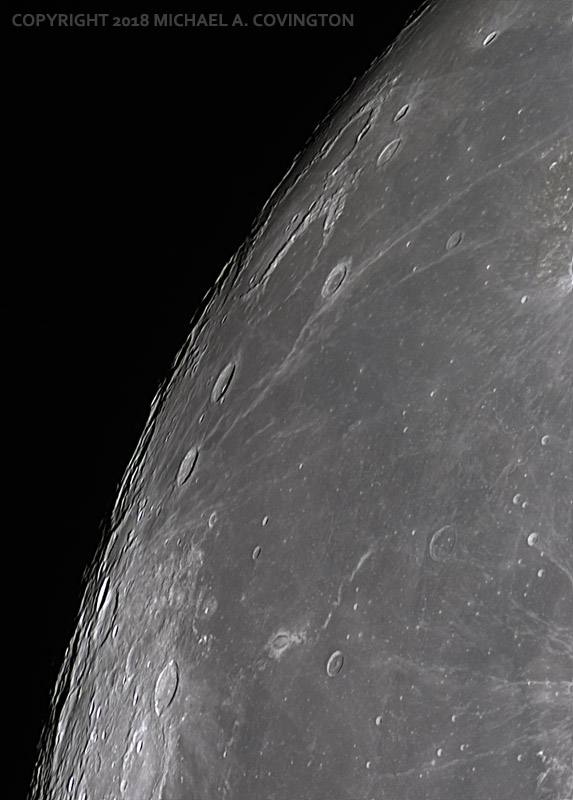
[Update:]
A correspondent points out that this picture gives a very good view of the tadpole-shaped
feature Reiner Gamma below center.
It looks like a crater with a tail but is not actually a crater; it may consist of dust
deposited under the influence of a magnetic field.
And here is the same picture, processed to emphasize color. You can tell that the
lunar plains have two kinds of rock, one redder and the other bluer.
The greens in highlights are probably a camera artifact.
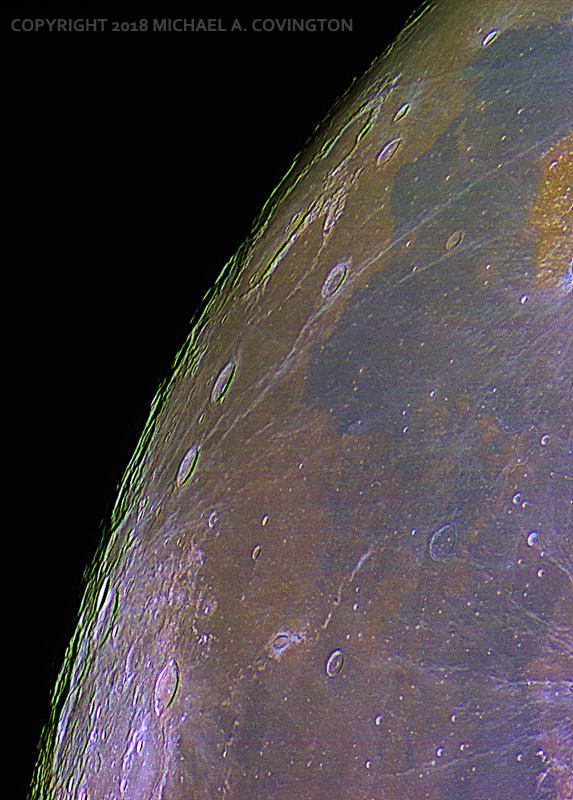
Permanent link to this entry
Byrgius
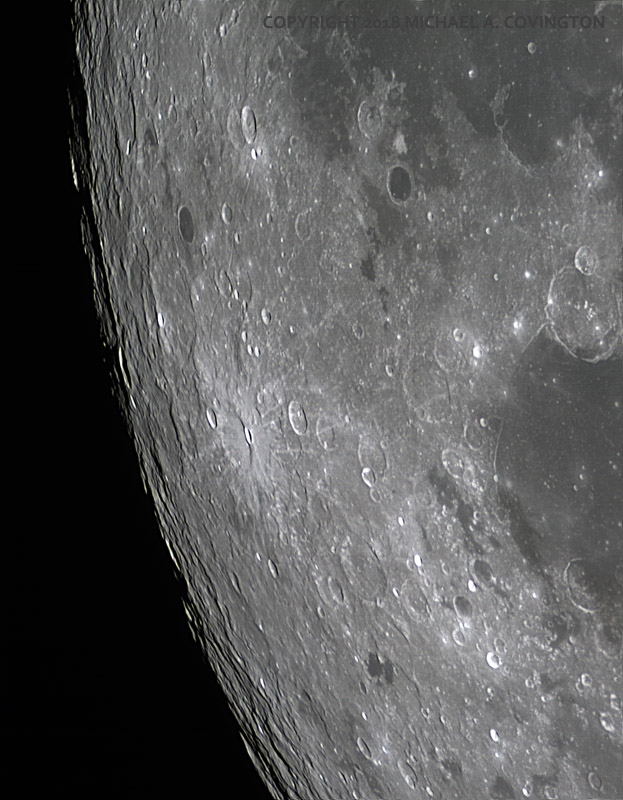
This is a more southerly region of the moon, taken on the same evening, with the
moon about 1 day before full. The most prominent crater
(in a light-colored patch to lower left of center) is Byrgius,
named for a man who made clocks for Kepler.
Permanent link to this entry


|
2018
August
5
|
Should "Not Secure" scare you?
The Chrome Browser has started marking web sites "Not Secure" if they use
conventional HTTP data communication instead of HTTPS.
Does that mean they're not safe? No.
But you shouldn't type passwords or other personal information into them.
Right now, Covington Innovations (including this page) is "Not Secure," but that
is no problem, because we don't ask you for any information.
You're not typing anything here (although we do have a link to the Bing search engine).
Here are what the new information looks like.
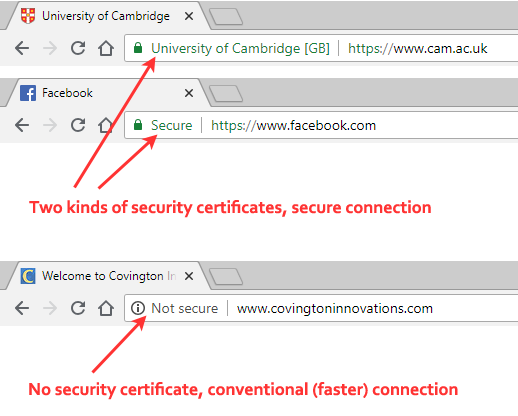
If a web site is "secure," it uses HTTPS, which buys you three things:
- Data sent to and from the site is encrypted. Anyone intercepting the data along the way
will not be able to read it (although they can see where it's coming from and going to).
- Nobody can change anything on the web page or insert anything into it.
This is uncommon, but some public Wi-Fi services might insert their own advertising
into web sites that people are viewing, or, if a network has been hacked, someone might
alter the data in other ways. HTTPS prevents that. If the data were altered,
it wouldn't decode at the other end.
- You know you're really connected to the site whose address you used.
Occasionally, people put out false information about where sites are located;
I think this is what's going on in the spam that I get that tells me I can see
pornography at addresses that obviously belong to businesses. (I haven't clicked.)
Someone could conceivably make your computer go somewhere else when you asked for
a particular site. But you could not get a successful HTTPS connection to that
kind of impostor.
Now is there any down side to this? Yes, there are two.
- It costs more to maintain the web site. HTTPS requires a certificate very
similar to those used to sign programs to prove they're authentic.
That enables the web server to insert codes that can be checked against a central
authority to prove the server and message are authentic.
This is a year-by-year expense for anyone who has a web site.
- It costs more to transmit the data. There is less caching, and it has to be encoded and decoded.
And let's get clear on what it's not:
- "Secure" does not mean any third party has checked my site's accuracy or honesty.
- "Secure" does not mean a site does not contain malware. It only means that you
will get what the web server sends out.
I expect charlatans to start trying to confuse people about that.
"This has to be true — see, your browser says it's Secure." Falsch.
Worse, people will think, mistakenly, that it is not safe to read
web sites that are not "Secure." Sure it is — as long as you are reading
them. Don't type information into them.
So is it worth it? I'm probably going to switch to HTTPS, mainly because I am in favor
of end-to-end authentication and privacy on the Internet.
(People ought to have the privacy that it looks like they have.)
But it is not urgent.
This is a "read-only" web site, into which people never type any personal
information, so there is not a lot for me to gain. If it had been a site where
people typed passwords or something, it would have been HTTPS since its inception.
Permanent link to this entry
Saturn
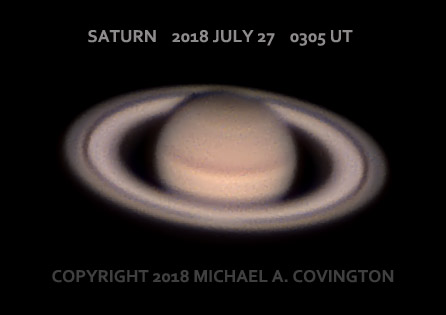
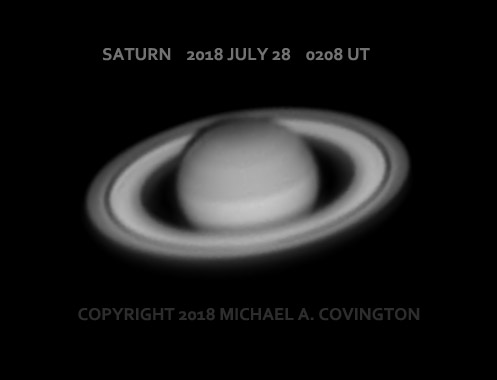

Here are some recent images of Saturn, taken with the same telescope and setup
as yesterday's pictures of Jupiter (scroll down).
The black-and-white images are infrared. Each is a stack of the best 50% to 75%
of thousands of video frames. Streaks in the rings of Saturn may be processing
artifacts, especially if they are not concentric with the rings themselves.
Permanent link to this entry


|
2018
August
4
|
Attack of the yellowjackets
Yesterday I was the victim of a booby-trap.
The people who pressure-washed my house found a yellowjacket
nest and put
a flat rock over it, but I didn't hear about it.
Yesterday I came along and wondered why the rock was out of place.
The yellow jackets swarmed out, and one of them followed me more than 30 feet
down the driveway and stung me on the face.
Another stung me when I came within about 15 feet of the nest later on.
Of course, we will have the exterminators in.
I came away with a new appreciation of these rather intelligent insects.
They are peaceable while foraging for food, but when they think their nest is
under attack, they focus on the task of driving away the attacker, or anything
that might be an attacker, and will try to defend a 20-foot perimeter,
which, for insects, is enormous. The stings are painful but of rather short duration
(recovery within 2 days, not like a a mosquito bite that lingers the rest of the week).
They have black-and-yellow warning stripes and want us to be afraid of them.
From their point of view, their yard is infested by human beings, which they
must eliminate.
I see it the other way around.
Permanent link to this entry
Jupiter
I have a large backlog of astrophotos to show you.
Here are some recent images of Jupiter.
All were taken from my back yard with an 8-inch telescope;
each is a stack of the best 50% to 75% of several thousand
video frames, enhanced by wavelet sharpening.
Color images were taken with an ASI120MC-S;
black-and-white images are in infrared light and were taken with
an ASI120MM-S and IR-pass filter.
You can see that the air is not equally steady every night.
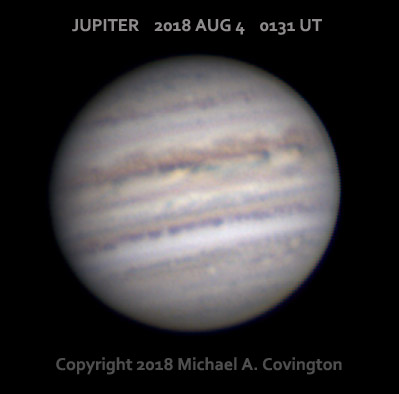
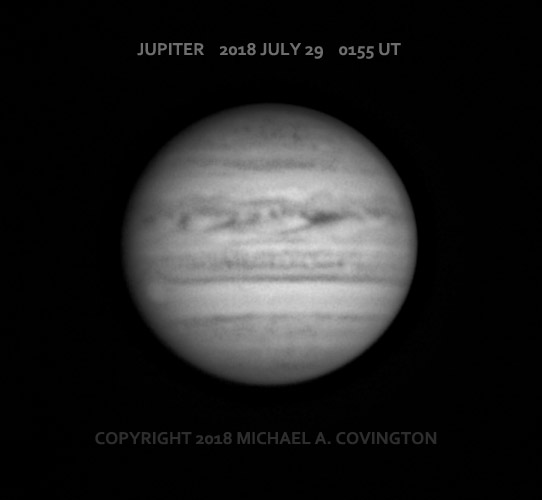
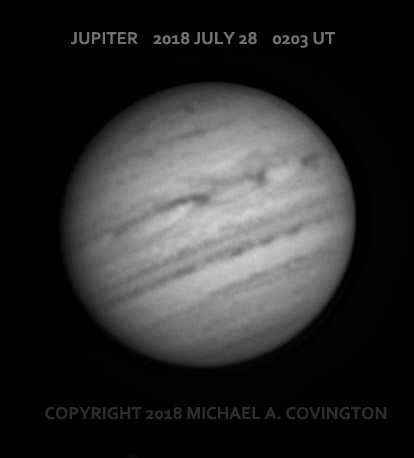
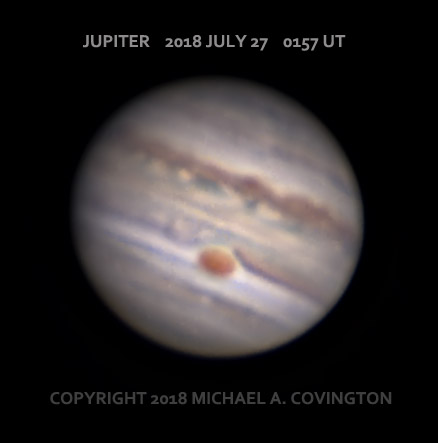
Permanent link to this entry


|
|
|
This is a private web page,
not hosted or sponsored by the University of Georgia.
Copyright 2018 Michael A. Covington.
Caching by search engines is permitted.
To go to the latest entry every day, bookmark
http://www.covingtoninnovations.com/michael/blog/Default.asp
and if you get the previous month, tell your browser to refresh.
Portrait at top of page by Krystina Francis.
This web site has never collected personal information
and is not affected by GDPR.
Some older pages that contain Google Ads may use cookies to manage the rotation of ads.
No personal information is collected or stored by Covington Innovations, and never has been.
This web site is based and served entirely in the United States.
In compliance with U.S. FTC guidelines,
I am glad to point out that unless explicitly
indicated, I do not receive substantial payments, free merchandise, or other remuneration
for reviewing or mentioning products on this web site.
Any remuneration valued at more than about $10 will always be mentioned here,
and in any case my writing about products and dealers is always truthful.
Reviewed
products are usually things I purchased for my own use, or occasionally items
lent to me briefly by manufacturers and described as such.
I am an Amazon Associate, and almost all of my links to Amazon.com pay me a commission
if you make a purchase. This of course does not determine which items I recommend, since
I can get a commission on anything they sell.
|
|




































